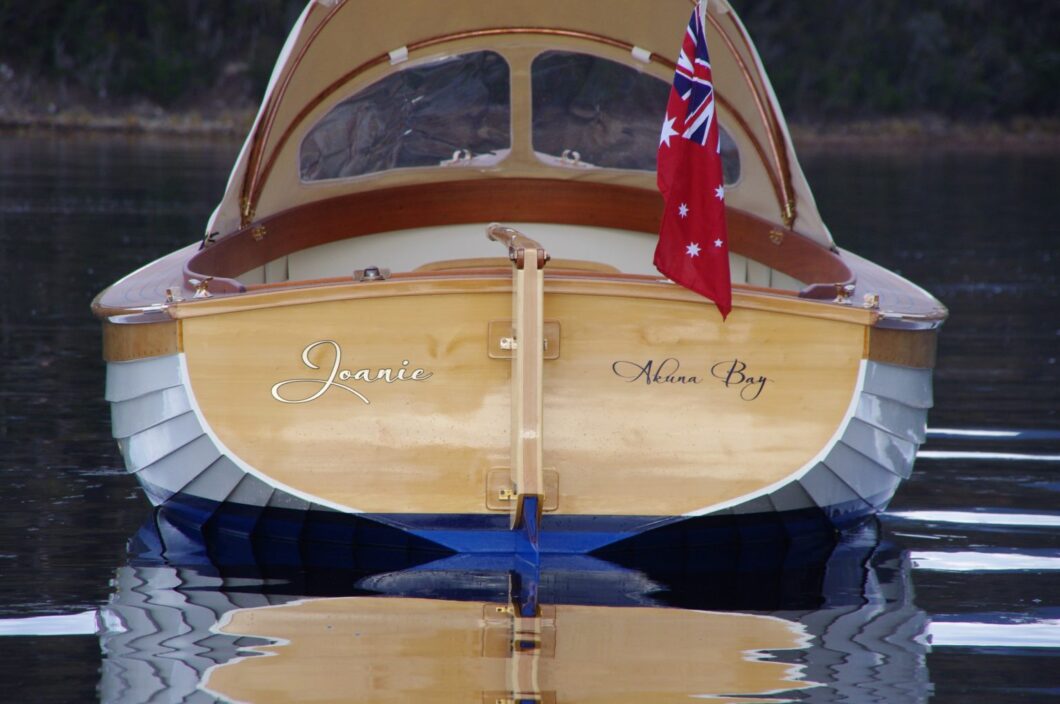Tasmania is the epicentre of Australian wooden boat building. As the home of what is considered the world’s finest boat building timbers, Huon Pine, Tassie has a rich heritage of boat building which began in the early years of colonisation and survives to this day.
According to the state government, the wooden boat building industry is worth $50 million per year into the Tasmanian economy, in addition to the economic and cultural benefits given impetus by events such as the biannual Australian Wooden Boat Festival each February.
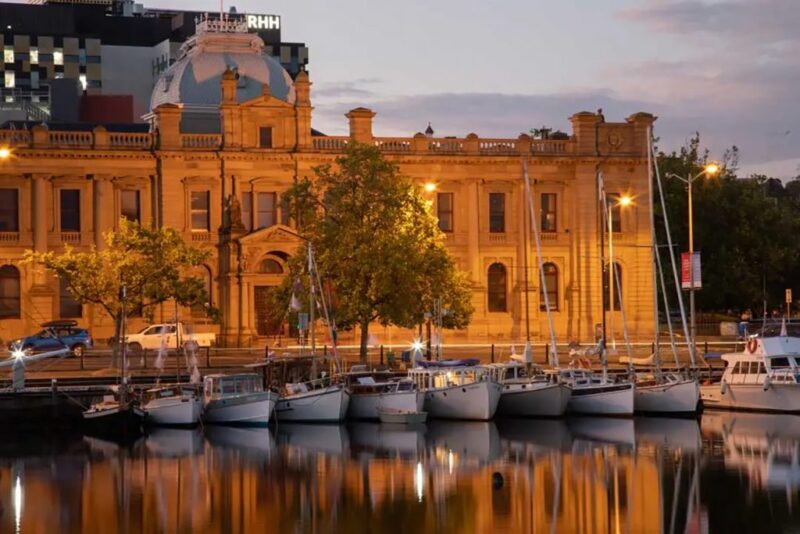
The Wooden Boat Centre, Australia’s only wooden boat building school, located on the Huon River at Franklin, is an organisation dedicated to continuing the tradition. In fact, its mission is “to ensure the traditional craft of wooden boat building ensure and remains a relevant part of contemporary maritime culture”.
The Centre holds courses, from half, full-day and week-long courses to a year full-time, and is involved in collaborative projects with other like-minded groups.
Cody Horgan, Head Shipwright and Manager of the Wooden Boat Centre (WBC), says that “historically, Tasmania has a proud history of boat building and shipwrighting”.
“Tasmania is home to various timbers that take so long to grow,” he explains. “Because of the unique timbers such as Huon Pine, King Billy, Celery Top Pine, Blue Gum, and the culture of the place, people place a great value on heritage, and we have a passion for it.”
As Cody explains, “Huon Pine is endemic to Tasmania and is now protected from logging. Huon Pine is scarce, so it has been put away for boat builders of the future, stored for us for restorations and building projects at the Wooden Boat Board Bank, managed by Sustainable Timber Tasmania.
“Its rarity makes it very precious,” he continues. “King Billy Pine is even rarer. We are very lucky to have the Boat Board Bank. It comes at a price, though: $12,000 to $14,000 a cubic metre.”

Huon Pine (Lagarostrobos franklinii) is a rainforest tree that grows in western and southern Tasmania. It is very fire sensitive and only grows in fire-free areas. It is slow growing and may live for over 2,000 years. The durability of the wood is due to the presence of the essential oil, methyl eugenol, which gives Huon pine its unique odour.
According to Cody, “restoration is a more responsible way of building boats”.
“In an effort to conserve the Huon Pine supplies, we build plywood dinghies, with only the visible parts in Huon Pine. Once or twice a year we build a boat out of Huon Pine and really celebrate. We are conscious that we’re using up a resource that we will never get back again.
“Restoration is particularly special. For me, I get paid to do my hobby. And for clients and boat owners with foresight and passion, they have the thrill of restoring and retaining the heritage, turning something dilapidated into something beautiful again. We are all passionate about it.”
The imperative to preserve wooden boats and pass on the restoration skills to the next generation are a matter of pride and historic preservation.
“We are trying to save the boats that exist,” says Cody. “That way, we use fewer resources. It’s a more responsible use of timber. These boats have a history, and we can pass down pleasure to next generations. It’s important to teach other people how they can make a living out of it and be responsible, AND have as much fun as I do!”
For Cody, working with wood is a totally pleasant experience. “It’s a nice medium, easy to shape, smells good, healthier than other forms of boat building, there’s a beautiful grain that tells a story. We can make functional boats which are artistically crafted. They are floating pieces of art.
“Those who share our vision are crucial to our work. A love for wooden boats is important. Without these visionary owners, there would be no heritage wooden vessels.”
After the 2023 restoration of the D-Class sailing yacht, Undine, which the WBC restored to her former glory and was then sold to the Commodore of Kettering Yacht Club, Mick Hawes, they are now working on two more.

Current projects include Minerva, the second D-Class and a project for students this year, and another D-Class called Pixie, which will be undertaken in 2025.
The one-year students are building an Appleseed boat that Cody designed; based on the template of an American Melonseed skiff.
“It’s the Huon Valley, we have a lot of apples here,” Cody says, explaining the name. “It will use plywood and Huon Pine transom, and lots of WEST SYSTEM epoxy!”

When asked to name the key proponents in the wooden boat building scene, Cody mentions Tom Blue, Jeremy Clowes Cygnet Wooden Boats, RM Marine in Kettering, Andrew Denman, Tasmanian Shipwrights & Co, and plenty more.
“They are all dedicated craftspeople and as enchanted with wooden boats as I am. We’re conscious we have a heritage to maintain.”
Andrew Denman, who has been operating Denman Marine since 2005 with a small team of dedicated craftspeople, specialises in the construction and repair of wooden boats using both traditional and modern construction methods and materials.
Andrew believes a number of factors contribute to Tasmania being the epicentre of wooden boat building in Australia. “First, is the beautiful endemic timbers we have available. These slow-grown timbers are renowned for being the best boat building timbers in the world.
“The second factor would be our favourable climate in which to build and maintain wooden boats.
“The third and most important factor is public recognition of the Tasmanian wooden boat building sector’s intangible cultural heritage, including the desire and support to preserve and transmit this heritage to future generations.
“I have trained several apprentices during my time, and it is wonderful to see the next generation of wooden boat builders stepping up to play their part in this ongoing story.”
For Andrew and his team, wood is pure pleasure to work with. “Every piece of timber is different and requires species-specific skills to get the best out of it,” he said.
“Wood is sustainable and stores carbon throughout a boat’s life and beyond. We are currently working on some water-ballasted daysailers/camp cruisers, some of which will be at the AWBF in 2025 (as will some of our previous boats). We are hoping to build a solar-electric coastal cruiser later this year.”
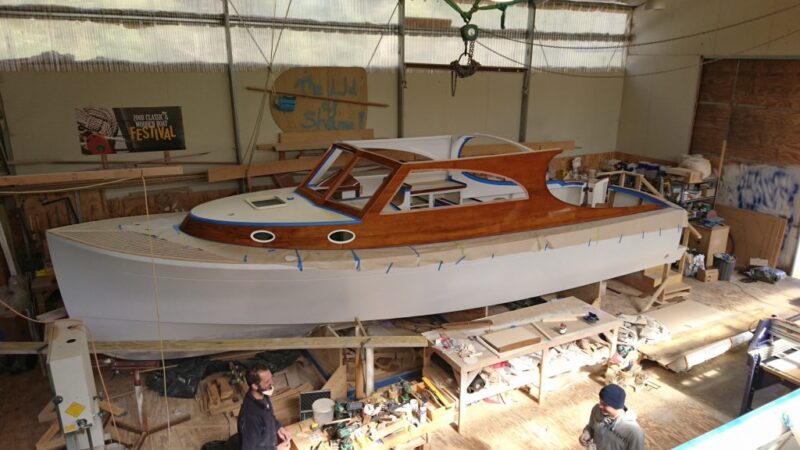
Graeme Broxam, Secretary of the Wooden Boat Guild of Tasmania is an authority on the history of wooden boat building in Tasmania. “Tasmanians have a special affinity for the sea,” he states, which is at the heart of the state’s boat building heritage and prowess to this day.
“Until the 1930s, all transport to and from Tasmania was by water, and before the development of quality roads and rail, much commerce within the state was also taken through our river and coastal systems. By the 1820s, Tasmanian-owned merchant ships could be seen in ports as far away as India, South Africa and Great Britain.
“In the 1820s, a home-grown fleet of whalers brought great prosperity, peaking in the late 1830s but remaining of some economic value right up to 1900. We were early adopters of new technology, with Hobart boasting its first two river steamers in 1832, just a year behind Sydney, and by the 1850s few coastal settlements were not served by steamers, in addition to a large fleet of sailing coaters.
“As well as commerce, Tasmanians soon began to enjoy the water for recreational pursuits, with yachting both on the Derwent and the Tamar in the 1830s. To service all of these needs, Tasmanians were obliged to establish boat and shipbuilding industries, and soon found that they were blessed with some of the world’s best shipbuilding timbers.
“Hardwoods such as the renowned Blue Gum were used for seagoing ships, while lighter pines such as Huon, King William and Celery Top Pines were more suited for boat building. Exports of timber, especially hardwood, could be exchanged for desired overseas shipbuilding timbers, like Kauri Pine from New Zealand and Oregon pine for North America: in ships frequently owned locally, and often built locally as well.”
In the early 1900s, timber shipbuilding was a significant Tasmanian industry, but petered out with the availability of iron and later steel steamships, beyond the technical capacity of local shipbuilders, as Graham recounts.
“Smaller coastal traders continued to be built into the 1950s. Since then, boat building, mostly fishing boats and pleasure craft, has continued on a moderate scale.
“The industry today is much hampered by the loss of access to speciality timbers, however, there are still considerable stockpiles of timber cut in the past that come onto the market from time to time. Much of this goes into an active restoration and repair industry. Due to the durability of the local pines, there are dozens of Tasmanian yachts, both remaining in the state and elsewhere, that were built a century or more ago.
“Although the inaccessibility to adequate quantities of timber have essentially destroyed the timber fishing boat construction industry, there are many dozens of traditional boats built before the 1990s still in commercial service: the oldest in current survey is Jean Nichols of 1940. Others are preserved as pleasure craft, including my own 46-foot yawl, Casilda (1915).

“Until the 1960s the majority of vessels built in Tasmania were of ‘traditional’ timber construction: clinker, carvel or batten-seam carvel that includes elements of both clinker and carvel construction. The beginnings of ‘modern’ construction techniques begins immediately after the end of WWII, when quality plywood first became available (plywood had been available since the 19th century but the bone-based glues then used made it of little use in a marine environment). The 11-foot plywood Mersey and Tamar class dinghies were introduced in 1946, while from the 1950s many overseas plywood boats (many from the prolific pen of British designer Jack Holt) were adopted as basic training and racing boats by Tasmanian boatyards.
“These continued to be the main small racing boats in Tasmania until fibreglass put in an appearance in the 1960s, and gradually claimed ascendance. The qualities of lightness, strength and aesthetic appeal continue to make timber a preferred material for the construction of pleasure craft. Due to the inability to obtain long lengths of boat-grade timber, cold-moulded laminated construction is common, as well as strip-planking where narrow planks are brought together via rebated, glued seams.”
Over the years, the Wooden Boat Guild of Tasmania has built two clinker-built 14-foot west coast piners’ punts and restored another that was probably over 100-years-old, rebuilt Tasmania’s oldest yacht (Terra Linna, 1881) and restored several pre-WWII dinghies. Although the Guild itself has mostly been involved with traditional boat building activities, many of its members have been actively involved in building boats with a range of “modern” techniques: plywood, cold-moulded laminated and strip-planked.
“All of these techniques are highly dependent on the availability of strong, durable glues such as WEST SYSTEM epoxy produced by ATL Composites. Other small organisations involved with similar activities are the Living Boat Trust at Franklin and Spring Bay Community Boatshed at Triabunna.”
This enthusiasm for all things wooden boat comes together in Tasmania every two years with the Australian Wooden Boat Festival in Hobart. Tasmania’s biggest single cultural event (with over 60,000 individual attendees), over 100 local, interstate and overseas wooden vessels are on display afloat, and smaller boats ashore bringing the total number to 550 vessels.
“Given this enthusiasm for wooden boats, and the availability of materials and skills to build and maintain them, wooden boats of all shapes and sizes will remain a significant part of Tasmania’s cultural landscape,” states Graham.
Paul Stephanus, General Manager/Festival Director of the Australian Wooden Boat Festival believes the preservation of the traditions of wooden boat building owe much to the Tasmanian way of life.
“Tasmanians have a proud culture of building boats in their garage, shed or back yard,” he observes. “It’s a different pace of life.”
The state’s Convict history lends a unique trait to its pride in traditional techniques.
“A lot of those who came here were seamen. And, not only is the best boat building timber available in Tasmania, we live on an island and we need to travel by boat.
“The Wooden Boat School in Franklin supports the continuation of traditional skills. Boat owners from Sydney, Melbourne and northern states bring their boats here to repair or refit and enjoy the cruising grounds. It’s part of our identity and a source of great pride. The Council and community are very supportive.”

The Festival has a major role in “preserving, honouring, showcasing and cherishing wooden boat culture”, Paul explains.
“The Australian Wooden Boat Festival showcases craftsmanship and celebrates restoration work. It also provides a deadline for projects and a place for the industry to gather.”
Everybody, from the connoisseur and craftsperson to those who first encounter them, admires wooden boats, says Paul.
“Wooden boats appeal to a deep human instinct. They have been a part of civilisation for 50,000 years, all over the world. Wood is so tactile; it was a living thing and it inspires us.
“In our modern lives, we are interfacing with reality through some other medium, such as screen time, whereas meeting up, understanding the boat on water, all the elements at once, craftsmanship and the human urge to travel, satisfies our thirst for real things.”
The 2025 show, 7 to 10 February, will run with the theme: “New Zealand and the Pacific”, and has already attracted boats from the West coast of the US, New Zealand and Japan.
“We have interest from Hawaii, Tahiti, New Caledonia, PNG, and support from the French government, the US government. The program will include an academic symposium, celestial navigation and Pacific exploration. It’s the biggest international focus we’ve done yet,” says Paul.
A long-time exhibitor at the Australian Wooden Boat Festival, ATL Composites is a proud supporter of the Tasmanian wooden boat industry and its many talented proponents. ATL will attend the 2025 Australian Wooden Boat Festival with an extensive range of WEST SYSTEM products and the Epifanes range of Marine Varnishes.

“Our company has been manufacturing WEST SYSTEM epoxy in Australia and New Zealand, under licence to Gougeon Brothers Inc, USA, since 1977, ” says Director Lorraine Duckworth.
“Initially supplying the professional boat building industry for cold-moulded and traditional wooden boat manufacture, we continued on with the promotion of cedar strip construction (timber composite) for both professional and amateur construction in the 1980’s, with WEST SYSTEM epoxy as an integral part of the construction techniques.
Today, WEST SYSTEM epoxy is a marine industry standard used for everything from basic long-lasting repairs to the construction of high-performance composite structures, and we continue to be dedicated to supporting the wooden boat industry.”
James Watson, from Red Car Marine agrees that Tasmania has a proud heritage of wooden boats, “and we have the highest boat ownership per capita in Australia”. Like every trade, it’s important to preserve wooden boat building.”
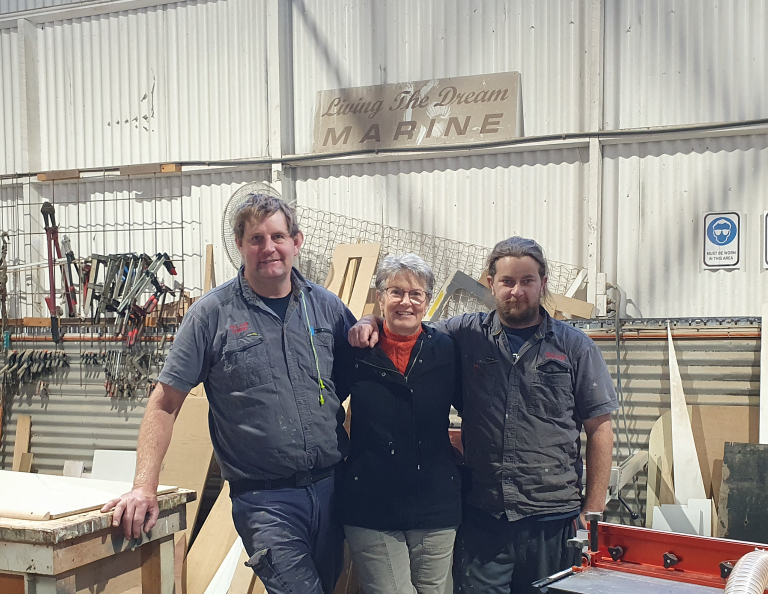
James, who’s working on the restoration of the ex-Governor General’s 1964 Millkraft boat; a 51-foot Spotted Gum trawler conversion to cruising pleasure boat, built in Sydney in 1946, and a 52-foot Celery Top Pine cray fishing vessel built in Triabunna. “This is a fairly large job as we have to take the amidship decks off and several other major refurbishments,” he says.
An industry veteran of more than 25 years, James enjoys “the unknown qualities of timber. It’s natural and like a gemstone, you really don’t know what it looks like until you work it. Then there’s a distinct smell of all the different timbers, which is magic.”
The trio from Tasmanian Shipwrights & Co – Nathan O’Neill, Jonathan Minnebo and Matt Stevens – are dedicated to the preservation and restoration of wooden boats which have a unique allure. “It’s what nature gave us and it’s sustainable,” says Nathan of the raw material.
All under 35, Nathan, Jonathan and Matt have different and complementary skill sets and backgrounds. Jonathan has 17 years of experience in the boat building industry, Matt, formerly lead shipwright at Denman Marine, brings a wealth of boat building and restoration experience to the job, and Nathan has a diverse and creative background. Together, the three partners have a full calendar of resto projects under the new enterprise established in October 2023.
“Wooden boat building is unique in that we are working with an organic material. Wood is the best material to capture both function and beauty,” Nathan says. “A boat is not just a means to an end to get a job done, it’s also art and emotion. Wood still captures that better than steel or composite.”
Matthew is just as passionate about wooden boats, saying “The allure of working on wooden boats is learning a craft that has been in place for hundreds of years.
“The knowledge that with a handful of tools, unchanged for the past century, and a selection of trees that can be regrown for future generations, you can build something aesthetically pleasing and practical that could carry you around the world using nothing but the wind. It is surely one of the most romantic trades.”
Jon enjoys the technical challenge, saying, “Whether it’s boat building or restoration, each job is different, bringing its own set of challenges.
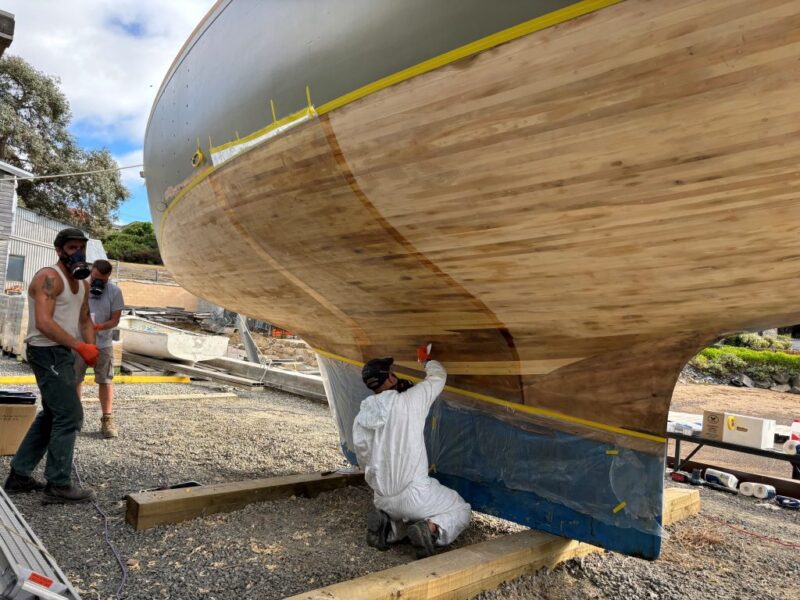
“Though no two jobs are alike, they all require thinking, planning, and problem-solving. It’s a mentally stimulating job that offers a big chance for learning and growth. With a basic foundation in using hand tools and machinery, passed down from earlier generations of boat builders, you gain the confidence and skills to take on new jobs. The satisfaction comes from challenging yourself, solving problems, and creating something to the best of your ability while picking up new skills.
“Looking back at your work and feeling proud of what you’ve accomplished is really rewarding. I’m always learning, not just from taking on new jobs, but also from Matthew and Nathan, as well as other boat builders who are always willing to share their knowledge and experience.”


